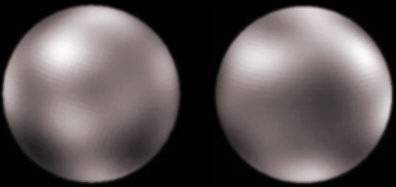Dwarf Planets
Is Pluto really a planet? A minor planet, certainly, but it is significantly smaller than any planetary body in the Solar System, at only 2,320 km in diameter. However, even that is larger than the largest known minor planet, Ceres, which is only 933 km in diameter. The image below shows Pluto, as imaged by the Hubble Space Telescope in 1996 (with some faint pinkish colouring to indicate that the surface may exhibit similar features to that of Triton, such as methane ice and frost).

[ NASA / JPL / Caltech ]
In reality, Pluto is just the largest known trans-Neptunian object, and happens to have a large satellite of its own, Charon. A common theory suggests that the Pluto-Charon system formed in a similar way to the accepted model of the Earth-Moon system's formation; that a collision between two large bodies resulted in a cloud of debris that coalesced into the two new bodies in orbit around each other.
* * *
August 2006
Pluto's future status as a planet hangs in the balance at the moment. Following a draft recommendation from the IAU committee, which will be debated over the next few days at the 2006 conference, Pluto is likely to become the 'type object' defining a new class of planetary objects, henceforth to be called 'Plutons' - which are in reality merely trans-Neptunian objects as we already know them. Charon will also be considered a Pluton in its own right (as the common centre of gravity - or barycentre - of the Pluto-Charon system lies outside Pluto), which will make Pluto and Charon a double planet system rather than a planet-and-satellite system as it has been known to date. The other eight planets are likely to be referred to as the 'classical planets' from now on.
At this conference, astronomers are also deciding how best to define the word 'planet', which is becoming a more and more vague term with each passing day, such is the current rate of discovery of new, extremely distant 'planetary' bodies. The draft makes the following two properties of a planetary body the defining factors determining whether or not it can be called a planet: -
- The object must follow its own, distinct orbit around its parent star (or the Sun in our case). In other words, it can't be a satellite.
- Gravity determines the other property: the object must be of sufficient mass to compress itself into a near-spherical shape.
Interestingly, the second factor means that several asteroids may also be considered 'planets'... and Ceres in particular.
* * *
| Siderial Period |
Perihelion (AU) |
Aphelion (AU) |
Inclination (degrees) |
Axial Tilt (deg) |
Axial Period (d, h, m) |
|---|---|---|---|---|---|
| 248.59 y | 29.73 | 49.33 | 17.1 | 118 | 6, 9, 16.8, R |
| Equatorial Diameter (km) |
Oblateness | Mass (Earth = 1) |
Density (water = 1) |
Albedo (geom.) |
No. of Satellites |
| 2, 320 | 0.000 | 0.003 | 1.1 | 0.3 | 1 |
Surface composition
Observations of Pluto made in early June 1999 with the Cooled Infrared Spectograph / Camera (CISCO) confirmed the presence of solid ethane (C2H6), methane (CH4), carbon monoxide (CO) and nitrogen (N2).
Past observations with the Subaru telescope have confirmed that water-ice is completely absent on Pluto, but abundant on Charon. This evidence suggests that the Pluto-Charon system may not have formed from a collision between two planetesimals, because if it had it would be likely that the surface compositions of both bodies would be very similar. As they aren't, the bodies may have drifted into orbit around each other after forming independently.
Missions to Pluto
As yet, no missions have ever been sent to Pluto. However, that will change if NASA manages to get New Horizons (which replaces the Pluto-Kuiper Express mission, cancelled in September 2000) off the ground in 2006. After a swift, direct journey to Pluto, the spacecraft will be instructed to look for other Kuiper Belt objects similar to Pluto.